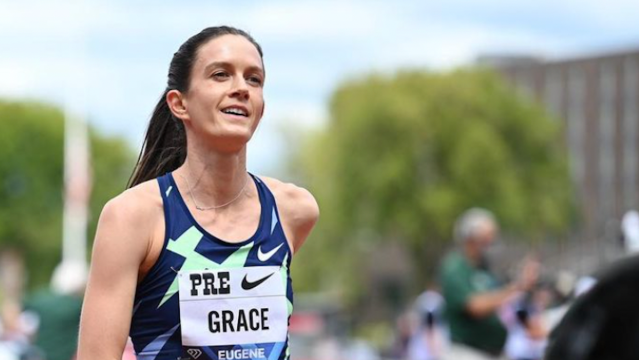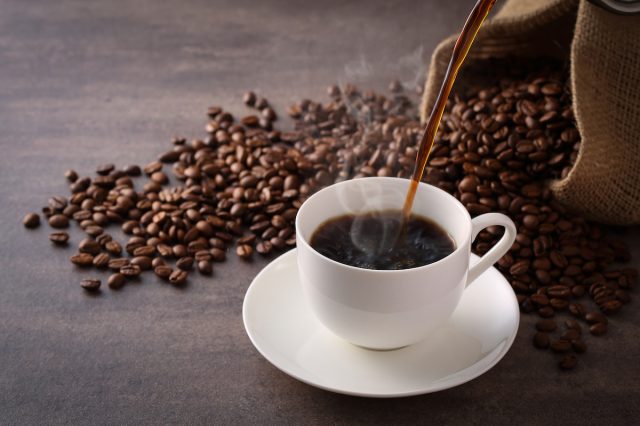Olympian Kate Grace in Workout Gear Runs on a “Funky Treadmill”

Kate Grace is having fun at the gym. In a new social media post the Olympic runner sprints on a curved treadmill in her workout gear. “I love this funky treadmill haaa,” she captioned the Instagram video. How does the athlete approach diet and fitness? Here is everything you need to know about her lifestyle habits.
Fueling Herself
“When I first started I thought you could eat yourself fast by not eating. It completely undercut me. I didn’t realize the science of actually needing carbohydrates, needing the various nutrients you need to refuel and basically supplement your training,” Kate told Runner’s World about her approach to diet. “Your training only works if you recover. My first year I was under-fueling myself, and in that sense, I really undercut my performance during championship seasons or when I went to the [Olympic] trials in 2012. I wasn’t in the place where I was going to make the team but I ran way below my PRs and I was just totally dead because I had been dieting.”
Eating Before Workouts
Timing is everything when it comes to eating, says Kate. “When you eat can be more important than what you’re eating. I’m religious about eating something within 10 to 15 minutes of a workout or any kind of activity. If, worst case, I am not able to get a bar or something that’s about 200 calories, I would eat anything versus nothing. I would eat crappier food instead of nothing,” she told Runner’s World.
Not Depriving Herself

Kate follows “what Lauren [Fleshman] and Jesse [Thomas] call a B-B+ diet throughout the year,” she told Runner’s World. “Giving myself permission to eat anything—I don’t have any foods that I would absolutely not eat because that allows me to maintain a pretty good quality of food throughout the year. When I’m going into competition season, so for like two months, I will cut out alcohol and dessert, aside from dark chocolate. That’s my way of upping the quality of the diet when I’m actually in competition season. The rest of year there’s nothing I don’t eat.”
Full Fat Foods

Kate isn’t afraid of eating fats. “If I was having a lot of sweet cravings, it meant I wasn’t getting enough carbs. I started to really crave ice cream and whipped cream—I was probably too low on fat. So one big change I made this year was I’d eat full-fat yogurt, which I never did before. While I’m not a fan of trends, I am a big proponent of full-fat yogurt because it really built me up,” she told Runner’s World.
Here Is What She Eats in a Day
For breakfast Kate “always” has the same thing when she is training, “half cup oats, chia, flax seed, a few frozen berries, walnuts, unsweetened almond milk, half cup yogurt, cinnamon or pumpkin spice,” she told Runner’s World. Lunch is her “second breakfast” and consists of “eggs fried in olive oil or soft boiled, topped on toast with olive oil and a quick raw veggie. Or I’ll have a microwaved burrito with a vegetable or salad if timing is tight.” Finally for dinner, she likes experimenting, “but I have my staples: taco night (slow cooked chicken, sautéed pepper and onion, black beans, avocado, and salad); veggie chicken stir fry over rice; pasta with meat sauce and salad.”
Coffee

“I’m not religious about it in the mornings…yet. I drink coffee before workouts especially if I’m nervous or feeling out of sorts. I usually drink a cup or 1.5 cups per day. If I start wanting a ton of coffee throughout the day, I hold back and take it as a sign to rest more versus powering through. I reduce intake the week before a race and then drink cold brew an hour before race time,” says Kate. According to the Cleveland Clinic, there are several benefits of drinking coffee in moderation. “It acts on your brain to improve memory, mood, reaction times, and mental function,” they say, citing a study finding that caffeine can improve endurance and performance during exercise. It is also antioxidant-rich, can ward off diabetes, prevent neurologic disease, lower cancer risk, and ward off depression, they point out.
Running
Kate’s main form of fitness is running. In her recent Instagram post Kate is “easing back into sprinting with uphill accelerations.” According to the Mayo Clinic, running is great for cardiovascular health, muscle building, and weight loss. “For every mile run, the average person will burn approximately 100 calories,” they say.




